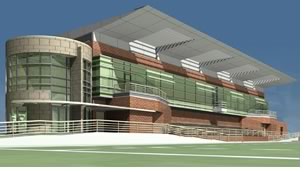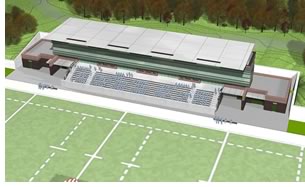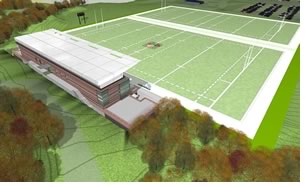

3/2006

by Russell Boniface
Associate Editor
“We few, we happy few, we band of brothers, for he today that sheds his blood with me shall be my brother”—Henry V, Shakespeare; and the Rugby Army motto
 The very nature of rugby—teamwork, sacrifice, physical endurance,
and ground maneuvering—resonates strongly among Army cadets. Perhaps
this is why the Rugby Club at the United States Military Academy (USMA)
at West Point has been a popular sport since its inception in 1961, despite
not having an official place to play other than nondescript patches of
campus grass. West Point has joined with Tampa-based Baker Barrios Architects
Inc., to remedy this problem with a new 14,000-square-foot, $12 million
rugby complex—knowing that if they build it, the Rugby Club will
definitely come.
The very nature of rugby—teamwork, sacrifice, physical endurance,
and ground maneuvering—resonates strongly among Army cadets. Perhaps
this is why the Rugby Club at the United States Military Academy (USMA)
at West Point has been a popular sport since its inception in 1961, despite
not having an official place to play other than nondescript patches of
campus grass. West Point has joined with Tampa-based Baker Barrios Architects
Inc., to remedy this problem with a new 14,000-square-foot, $12 million
rugby complex—knowing that if they build it, the Rugby Club will
definitely come.
Commissioned by the Association of Graduates of West Point, Baker Barrios provided the design and program management for the new Anderson Rugby Complex at West Point. Construction of the facility began in December 2005, with an anticipated completion date of May 2006. Through successful fundraising, the Association of Graduates has made possible the complex. Alumni Penny and Lee Anderson pledged $8.5 million, covering more that half the cost of the facility.
Background: An uneven playing field
The USMA at West Point overlooks the Hudson River in upstate New York
50 miles north of New York City. West Point has about 4,000 undergraduates
and 500 faculty members. The Army Rugby Club has become one of West
Point’s most popular sports, coinciding with rugby becoming a
fast-growing collegiate sport now played at more than 440 U.S. colleges.
Rugby requires technical, tactical, and strategic skills—all
skills that Army cadets learn in their Academy training. According
to the USMA at West Point Web site, Army rugby players view the game
as ground combat, and since 2004—by their own choice—only
one graduate of West Point who played rugby went into a branch of service
other than combat arms.
All cadet athletes at West Point are called the Army Black Knights, and the Rugby Club cadets—nicknamed the “Army Ruggers”—don black, gold, and gray uniforms. There are both men’s and women’s teams, with 90 cadets divided into four teams. The “A” and “B” sides compete in the very competitive New England Rugby Football Union, while the “C” and “D” sides play in the Metropolitan New York Rugby Football Union.
In 1980, the USA Rugby Collegiate Championship playoff system was established. Since then, Army Rugby teams—despite having no facility to call their own—have qualified for 10 “Final Four” tournaments six times in the last decade, and every “Sweet 16” collegiate rugby tournament ever held. And there is also the annual Army-Navy Rugby Classic. But collegiate rugby has become increasingly competitive, with dozens of schools like the University of California, Berkeley, that have state-of-the-art dedicated rugby complexes, well-trained teams, and multi-million dollar endowments that support everything from uniforms to coaches and travel.
During the last decade, many of the Academy’s athletic facilities continued to fall into disrepair due to cutbacks in government funding, affecting West PointÆs ability to recruit and train talented cadet athletes. Add to that the fact that the Rugby Club never had a permanent home from the start. Although the federal government provides a large portion of West Point’s funding, it only goes to either military training or academics. The Association of Graduates of West Point was determined to get the Rugby Club a home, and eventually raised the funds to build them one. A key factor in reducing the cost was for the association to manage the project themselves with an outside architecture firm.
 New rugby complex blends with West Point history
New rugby complex blends with West Point history
To be perched on a plateau in a wooded setting with scenic views of the
surrounding Hudson Valley, the two-level Anderson Rugby Complex will
have 750 permanent seats, with portable stands allowing for a 2,800
seating capacity. The complex will have two full-sized, regulation
rugby fields, known as “pitches.” Both pitches will be
lighted. Baker Barrios Associate Principal Robert Ledford, AIA, has
been the project manager for several West Point projects besides the
new rugby complex, including the football stadium press box, basketball
office at Randal Hall, skeet trap facility, interactive learning center,
and Army Hall of Sports.
For the rugby stadium, Ledford specified a brick exterior, combined with concrete, glass, stone, and a white, overhanging roof. “The brick exterior of the Rugby Complex will tie into the architectural vernacular of the historic nature of the West Point campus, where there are many stacked granite and brick facades,” he says. “Being along the waterfront, the complex will also take advantage of the natural Hudson Valley views and blend with the brick architecture in the surrounding valley.
“One of the sensitivities with being in the Hudson Valley was making sure that we didn’t have light pollution,” continues Ledford. “There are houses right across the river, so part of the design is that the Rugby Complex seamlessly blends with the Academy campus and the natural surroundings, and that the lighting doesn’t adversely impact the neighborhoods across the river.”
The new facility will have the bleachers, an 1,800-square-foot observation balcony, a press box and skybox/VIP area, a multipurpose Great Room overlooking the fields for catered events, a weight room, a training room, a cardio-pulmonary fitness area, home and visitor locker rooms, catering facilities, offices for coaches and referees, a camera station, conference rooms, maintenance facilities, and exhibit space.
Guarding their turf
The complex will have one natural grass pitch and one artificial, both
regulation size, to allow play and practice year-round. The rugby scrum
(when opposing forwards bind together in a unit and push against each
other to try to win the ball with their feet) can really tear up grass,
so the synthetic turf allows them to practice while they can keep the
game-day pitch pristine. The size of the grass blades is important
to the game, Ledford points out. “It makes the ball react differently
in different sports. The synthetic turf will have blades that are two-to-three
inches long—the right size for sports like rugby where the players
need traction, unlike shorter blades, which are better for sports like
soccer, baseball, and lacrosse, where the ball is going to bounce and
roll.”
New technology helps greatly minimize the risk of injury to cadets while running and tackling on the modern artificial turf. “Our synthetic turf is multiple generations removed from the old Astroturf, which was very hard,” explains Ledford. “The current artificial turf has a sand and ground rubber tire infill that gives it a natural grass feel, so it responds just like a natural grass turf. There has been a lot of research and development with synthetic turf. Teams can lose a lot of money with player injuries. Since it comes in strips, it is heat-seamed and stitched together, so it doesn’t peel apart and pose an injury threat.
“This will be the finest rugby facility in the nation,” says Ledford. “It will be a dedicated rugby facility, used by both men and women’s teams. It will keep up West Point’s margin of excellence and leadership, and will allow the Rugby Club to remain a powerhouse. The Alumni Association did a nice job with the fundraising.”
 Kick off!
Kick off!
With construction under way, the facility will be ready for play this
spring, with a formal dedication this summer. Alumnus Lee Anderson,
a football, basketball, and track participant while at the academy,
believes that athletics played a critical role in his success throughout
life. “It’s a great privilege for Penny and me to help
make this state-of-the art complex available to the Army Ruggers. It
is our sincere hope that we can be present someday to see a national
championship played there with one team wearing the ‘black, gold,
and gray.’”
Baker Barrios Architects’ Principal-in-Charge Carlos Barrios, AIA, believes the project met client expectations “The principal challenge of the project was to capture the essence of West Point’s tradition into an architectural statement reinforcing a sense of permanence, the overall theme of the academy, and their motto of Duty, Honor, Country.”
Army Head Coach Rich Pohlidal says he still can’t stop smiling. “With the increased capacities of the Anderson Rugby Complex, we will have leveled the playing fields for the Army Rugby Team. Our goal is to reach a level of training sophistication that sets a new benchmark for collegiate rugby in this nation.”
Concludes Ledford, “It was a great opportunity for us to be involved. There is a great sense of patriotism at West Point. The Anderson Rugby Complex leans toward a Modern design that looks to the future of the campus, the team, and the Army. It definitely falls into the development of our future West Point officers.”
Copyright 2006 The American Institute of Architects.
All rights reserved. Home Page ![]()
![]()
Did you know . . .
• Rugby is played by men and women in more than 100 countries.
• A match is played out in two 40-minute halves, with a 5-minute half time. The game is non-stop—no huddles, instant replay breaks, broken plays—all the while displaying sportsmanship and teamwork (no strutting or posturing). Talking back to the ref is not tolerated!
• A rugby field is 100 meters (about 330 feet) in length and 69 meters (225 feet) in width. The uprights of the H-shaped goalposts are 10 meters high, 5.6 meters apart, connected by a horizontal crossbar 3 meters above the ground.
• A rugby team consists of 15 players, generally divided into 8 “forwards” and 7 “backs.” Players may not be tackled without the ball.
• Rugby is said to have been originated in 1823 during a football (“soccer”) game by a boy named Webb Ellis at Rugby School in Rugby, England. He wanted to score the winning goal before the looming 5 o’clock school bell but became so frustrated by his inability to kick the ball that he picked it up and ran forward with it to cross the goal line. While there is no actual record of this event, the story—fact or myth—has stuck.
• Impress your friends with Rugby Scoring 101! A “try” (5 points) is similar to an American football touchdown, but when the ball carrier crosses the goal, play continues until the player grounds the ball; a kicked “conversion” attempt (2 points) through the goal posts follows; and a drop goal (3 points), a risky maneuver, is a drop kick attempt through the goal posts. An attempt can occur any time, by any player, from anywhere on the pitch. Often used as a last resort, many games have been won in this dramatic fashion, often at the final whistle.
![]()